Conditional Loss of the Exocyst Component Exoc5 in Retinal Pigment Epithelium (RPE) Results in RPE Dysfunction, Photoreceptor Cell Degeneration, and Decreased Visual Function
Abstract
1. Introduction
2. Results
2.1. Loss of Exoc5 in Zebrafish Results in RPE and Photoreceptor Phenotypes
2.2. Loss of Exoc5 in Zebrafish Results in Early Retinal Phenotypes
2.3. RPE-Specific Ablation of Exoc5 in Mice Cause Retinal Cell Degeneration
2.4. Conditional Exoc5 Knockout Mice Show Defects in Photoreceptor Development
2.5. Conditional Sec10 fl/fl, Best1-Cre+ KO Mice Show Significantly Reduced Rod Visual Function and RPE Integrity as Assessed by Electroretinography (ERG)
3. Discussion
4. Materials and Methods
4.1. Materials
4.2. Animal Use Approval
4.3. Zebrafish Husbandry
4.4. Mouse Husbandry
4.5. Mouse Retina Dissection, Immunohistochemistry, and Fluorescence Imaging
4.6. Transmission Electron Microscopy (TEM)
4.7. Electroretinography (ERG)
4.8. Statistics
5. Conclusions
Supplementary Materials
Author Contributions
Funding
Institutional Review Board Statement
Informed Consent Statement
Data Availability Statement
Conflicts of Interest
References
- Yorston, D. Retinal Diseases and VISION 2020. Community Eye Health 2003, 16, 19–20. [Google Scholar]
- Gilbert, C.; Foster, A. Childhood Blindness in the Context of VISION 2020—The Right to Sight. Bull. World Health Organ. 2001, 79, 227–232. [Google Scholar] [PubMed]
- Wright, A.F.; Chakarova, C.F.; Abd El-Aziz, M.M.; Bhattacharya, S.S. Photoreceptor Degeneration: Genetic and Mechanistic Dissection of a Complex Trait. Nat. Rev. Genet. 2010, 11, 273–284. [Google Scholar] [CrossRef] [PubMed]
- Smyth, B.J.; Snyder, R.W.; Balkovetz, D.F.; Lipschutz, J.H. Recent Advances in the Cell Biology of Polycystic Kidney Disease. Int. Rev. Cytol. 2003, 231, 51–89. [Google Scholar] [PubMed]
- Webber, W.A.; Lee, J. Fine Structure of Mammalian Renal Cilia. Anat. Rec. 1975, 182, 339–343. [Google Scholar] [CrossRef] [PubMed]
- Choi, S.Y.; Chacon-Heszele, M.F.; Huang, L.; McKenna, S.; Wilson, F.P.; Zuo, X.; Lipschutz, J.H. Cdc42 Deficiency Causes Ciliary Abnormalities and Cystic Kidneys. J. Am. Soc. Nephrol. 2013, 24, 1435–1450. [Google Scholar] [CrossRef]
- Fogelgren, B.; Lin, S.Y.; Zuo, X.; Jaffe, K.M.; Park, K.M.; Reichert, R.J.; Bell, P.D.; Burdine, R.D.; Lipschutz, J.H. The Exocyst Protein Sec10 Interacts with Polycystin-2 and Knockdown Causes PKD-Phenotypes. PLoS Genet. 2011, 7, e1001361. [Google Scholar] [CrossRef] [PubMed]
- Seixas, C.; Choi, S.Y.; Polgar, N.; Umberger, N.L.; East, M.P.; Zuo, X.; Moreiras, H.; Ghossoub, R.; Benmerah, A.; Kahn, R.A. Arl13b and the Exocyst Interact Synergistically in Ciliogenesis. Mol. Biol. Cell. 2016, 27, 308–320. [Google Scholar] [CrossRef]
- Zuo, X.; Fogelgren, B.; Lipschutz, J.H. The Small GTPase Cdc42 is Necessary for Primary Ciliogenesis in Renal Tubular Epithelial Cells. J. Biol. Chem. 2011, 286, 22469–22477. [Google Scholar] [CrossRef]
- Zuo, X.; Guo, W.; Lipschutz, J.H. The Exocyst Protein Sec10 Is Necessary for Primary Ciliogenesis and Cystogenesis In Vitro. Mol. Biol. Cell. 2009, 20, 2522–2529. [Google Scholar] [CrossRef]
- Lipschutz, J.H.; Guo, W.; O'Brien, L.E.; Nguyen, Y.H.; Novick, P.; Mostov, K.E. Exocyst Is Involved in Cystogenesis and Tubulogenesis and Acts by Modulating Synthesis and Delivery of Basolateral Plasma Membrane and Secretory Proteins. Mol. Biol. Cell. 2000, 11, 4259–4275. [Google Scholar] [CrossRef]
- Choi, S.Y.; Baek, J.I.; Zuo, X.; Kim, S.H.; Dunaief, J.L.; Lipschutz, J.H. Cdc42 and sec10 Are Required for Normal Retinal Development in Zebrafish. Invest. Ophthalmol. Vis. Sci. 2015, 56, 3361–3370. [Google Scholar] [CrossRef]
- Dixon-Salazar, T.J.; Silhavy, J.L.; Udpa, N.; Schroth, J.; Bielas, S.; Schaffer, A.E.; Olvera, J.; Bafna, V.; Zaki, M.S.; Abdel-Salam, G.H.; et al. Exome Sequencing Can Improve Diagnosis and Alter Patient Management. Sci. Transl. Med. 2012, 4, 138ra78. [Google Scholar] [CrossRef]
- Khan, A.O.; Oystreck, D.T.; Seidahmed, M.Z.; AlDrees, A.; Elmalik, S.A.; Alorainy, I.A.; Salih, M.A. Ophthalmic Features of Joubert syndrome. Ophthalmology 2008, 115, 2286–2289. [Google Scholar] [CrossRef] [PubMed]
- Lobo, G.P.; Fulmer, D.; Guo, L.; Zuo, X.; Dang, Y.; Kim, S.H.; Su, Y.; George, K.; Obert, E.; Fogelgren, B. The Exocyst Is Required for Photoreceptor Ciliogenesis and Retinal Development. J. Biol. Chem. 2017, 292, 14814–14826. [Google Scholar] [CrossRef]
- Fogelgren, B.; Polgar, N.; Lui, V.H.; Lee, A.J.; Tamashiro, K.K.; Napoli, J.A.; Walton, C.B.; Zuo, X.; Lipschutz, J.H. Urothelial Defects from Targeted Inactivation of Exocyst Sec10 in Mice Cause Ureteropelvic Junction Obstructions. PLoS ONE. 2015, 10, e0129346. [Google Scholar] [CrossRef]
- Iacovelli, J.; Zhao, C.; Wolkow, N.; Veldman, P.; Gollomp, K.; Ojha, P.; Lukinova, N.; King, A.; Feiner, L.; Esumi, N.; et al. Generation of Cre Transgenic Mice with Postnatal RPE-Specific Ocular Expression. Invest. Ophthalmol. Vis. Sci. 2011, 52, 1378–1383. [Google Scholar] [CrossRef] [PubMed]
- Woodell, A.; Coughlin, B.; Kunchithapautham, K.; Casey, S.; Williamson, T.; Ferrell, W.D.; Atkinson, C.; Jones, B.W.; Rohrer, B. Alternative Complement Pathway Deficiency Ameliorates Chronic Smoke-Induced Functional and Morphological Ocular Injury. PLoS ONE. 2013, 8, e67894. [Google Scholar] [CrossRef] [PubMed]
- Gargini, C.; Terzibasi, E.; Mazzoni, F.; Strettoi, E. Retinal Organization in the Retinal Degeneration 10 (Rd10) Mutant Mouse: A Morphological and ERG Study. J. Comp. Neurol. 2007, 500, 222–238. [Google Scholar] [CrossRef]
- Perkins, B.D.; Fadool, J.M. Photoreceptor Structure and Development Analyses Using GFP Transgenes. Methods Cell. Biol. 2010, 100, 205–218. [Google Scholar]
- Lee, B.; Baek, J.I.; Min, H.; Bae, S.H.; Moon, K.; Kim, M.A.; Kim, Y.-R.; Fogelgren, B.; Lipschutz, J.H.; Lee, K.-Y. Exocyst Complex Member EXOC5 Is Required for Survival of Hair Cells and Spiral Ganglion Neurons and Maintenance of Hearing. Mol. Neurobiol. 2018, 55, 6518–6532. [Google Scholar] [CrossRef]
- Fulmer, D.; Toomer, K.; Guo, L.; Moore, K.; Glover, J.; Moore, R.; Glover, J.; Moore, R.; Stairley, R.; Lobo, G.; et al. Defects in the Exocyst-Cilia Machinery Cause Bicuspid Aortic Valve Disease and Aortic Stenosis. Circulation 2019, 140, 1331–1341. [Google Scholar] [CrossRef]
- Wood, C.R.; Huang, K.; Diener, D.R.; Rosenbaum, J.L. The Cilium Secretes Bioactive Ectosomes. Curr. Biol. 2013, 23, 906–911. [Google Scholar] [CrossRef] [PubMed]
- Wang, J.; Silva, M.; Haas, L.A.; Morsci, N.S.; Nguyen, K.C.; Hall, D.H.; Barr, M.M. C. Elegans Ciliated Sensory Neurons Release Extracellular Vesicles that Function in Animal Communication. Curr. Biol. 2014, 24, 519–525. [Google Scholar] [CrossRef]
- Nager, A.R.; Goldstein, J.S.; Herranz-Perez, V.; Portran, D.; Ye, F.; Garcia-Verdugo, J.M.; Nachury, M.V. An Actin Network Dispatches Ciliary GPCRs into Extracellular Vesicles to Modulate Signaling. Cell 2017, 168, 252–263 e14. [Google Scholar] [CrossRef]
- Zuo, X.; Kwon, S.H.; Janech, M.G.; Dang, Y.; Lauzon, S.D.; Fogelgren, B.; Polgar, N.; Lipschutz, J.H. Primary Cilia and the Exocyst Are Linked to Urinary Extracellular Vesicle Production and Content. J. Biol. Chem. 2019, 294, 19099–19110. [Google Scholar] [CrossRef]
- Strauss, O. The Retinal Pigment Epithelium in Visual Function. Physiol. Rev. 2005, 85, 845–881. [Google Scholar] [CrossRef] [PubMed]
- den Hollander, A.I.; Roepman, R.; Koenekoop, R.K.; Cremers, F.P.M. Leber Congenital Amaurosis: Genes, Proteins, and Disease Mechanisms. Prog. Retin. Eye. Res. 2008, 27, 391–419. [Google Scholar] [CrossRef]
- Rohrer, B.; Lohr, H.R.; Humphries, P.; Redmond, T.M.; Seeliger, M.W.; Crouch, R.K. Cone Opsin Mislocalization in Rpe65-/- Mice: A. Defect that Can be Corrected by 11-Cis Retinal. Invest. Ophthalmol. Vis. Sci. 2005, 46, 3876–3882. [Google Scholar] [CrossRef] [PubMed]
- Fan, J.; Rohrer, B.; Frederick, J.M.; Baehr, W.; Crouch, R.K. Rpe65-/—and Lrat-/—Mice: Comparable Models of Leber Congenital Amaurosis. Invest. Ophthalmol. Vis. Sci. 2008, 49, 2384–2389. [Google Scholar] [CrossRef]
- Kanow, M.A.; Giarmarco, M.M.; Jankowski, C.S.R.; Tsantilas, K.; Engel, A.L.; Du, J.; Linton, J.D.; Farnsworth, C.C.; Sloat, S.R.; Rountree, A.; et al. Biochemical Adaptations of the Retina and Retinal Pigment Epi–Thelium Support a Metabolic Ecosystem in the Vertebrate Eye. eLife 2017, 6, e28899. [Google Scholar] [CrossRef]
- Brown, E.E.; DeWeerd, A.J.; Ildefonso, C.J.; Lewin, A.S.; Ash, J.D. Mitochondrial Oxidative Stress in the Retinal Pigment Epithelium (RPE) Led to Metabolic Dysfunction in Both the RPE and Retinal Photoreceptors. Redox. Biol. 2019, 24, 101201. [Google Scholar] [CrossRef] [PubMed]
- Shah, N.; Ishii, M.; Brandon, C.; Ablonczy, Z.; Cai, J.; Liu, Y.; Chou, C.J.; Rohrer, B. Extracellular Vesicle-Mediated Long-Range Communication in Stressed Retinal Pigment Epithelial Cell Monolayers. Biochim. Biophys. Acta Mol. Basis Dis. 2018, 1864, 2610–2622. [Google Scholar] [CrossRef]
- Nicholson, C.; Shah, N.; Ishii, M.; Annamalai, B.; Brandon, C.; Rodgers, J.; Nowling, T.; Rohrer, B. Mechanisms of Extracellular Vesicle Uptake in Stressed Retinal Pigment Epithelial Cell Monolayers. Biochim. Biophys. Acta Mol. Basis Dis. 2020, 1866, 165608. [Google Scholar] [CrossRef] [PubMed]
- Nicholson, C.; Ishii, M.; Annamalai, B.; Chandler, K.; Chwa, M.; Kenney, M.C.; Shah, N.; Rohrer, B. J or H Mtdna Haplogroups in Retinal Pigment Epithelial Cells: Effects on Cell Physiology, Cargo in Extracellular Vesicles, and Differential Uptake of Such Vesicles by Naïve Recipient Cells. Biochim. Biophys. Acta Gen. Subj. 2021, 1865, 129798. [Google Scholar] [CrossRef] [PubMed]
- Salinas, R.Y.; Pearring, J.N.; Ding, J.D.; Spencer, W.J.; Hao, Y.; Arshavsky, V.Y. Photoreceptor Discs Form Through Peripherin-Dependent Suppression of Ciliary Ectosome Release. J. Cell. Biol. 2017, 216, 1489–1499. [Google Scholar] [CrossRef] [PubMed]
- Pazour, G.J.; Baker, S.A.; Deane, J.A.; Cole, D.G.; Dickert, B.L.; Rosenbaum, J.L.; Witman, G.B.; Besharse, J.C. The Intraflagellar Transport Protein, IFT88, Is Essential for Vertebrate Photoreceptor Assembly and Maintenance. J. Cell. Biol. 2002, 157, 103–113. [Google Scholar] [CrossRef]
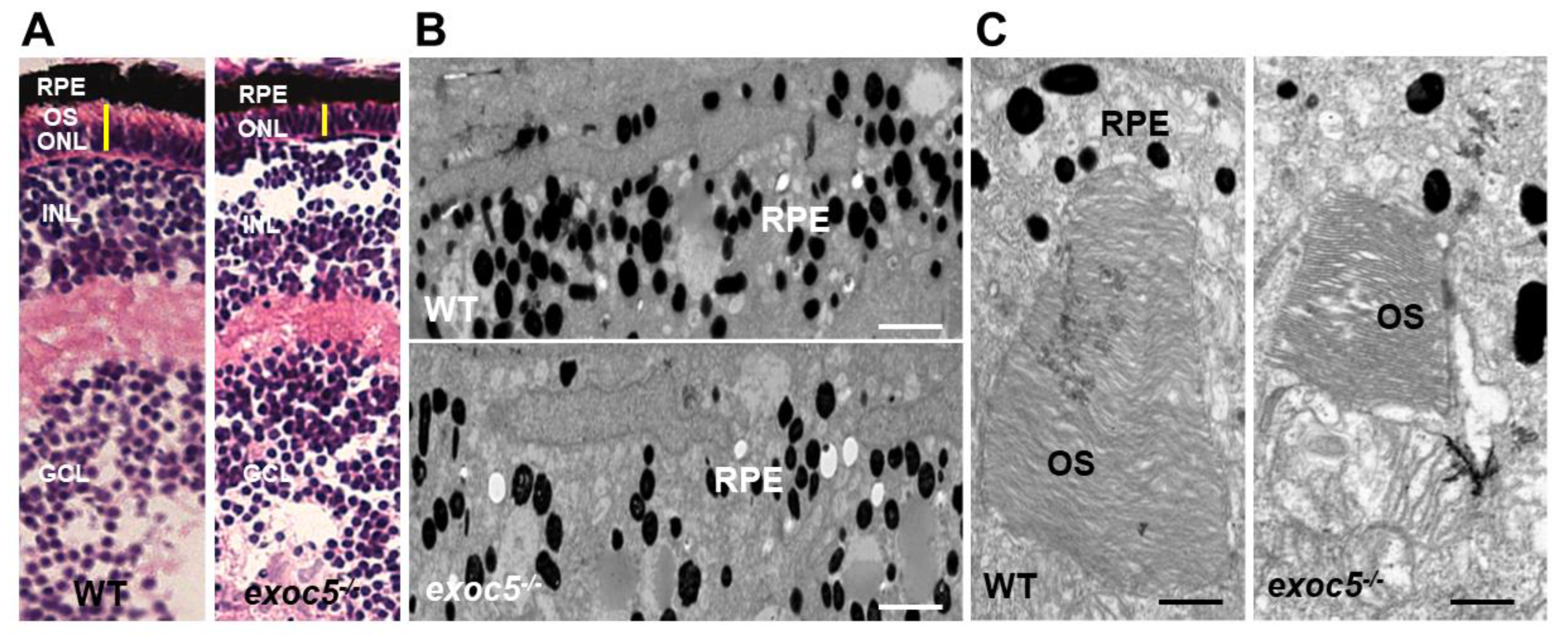
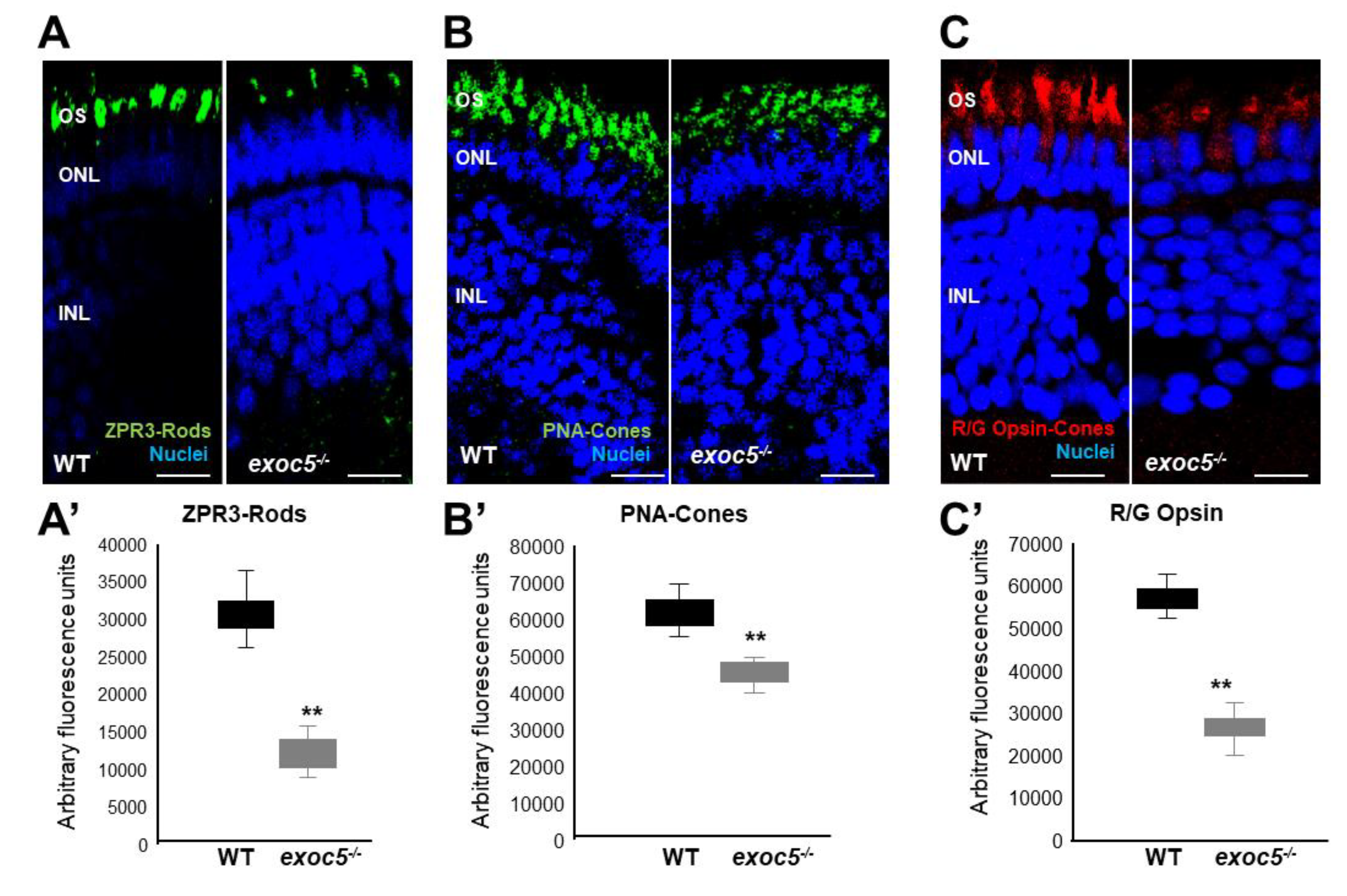
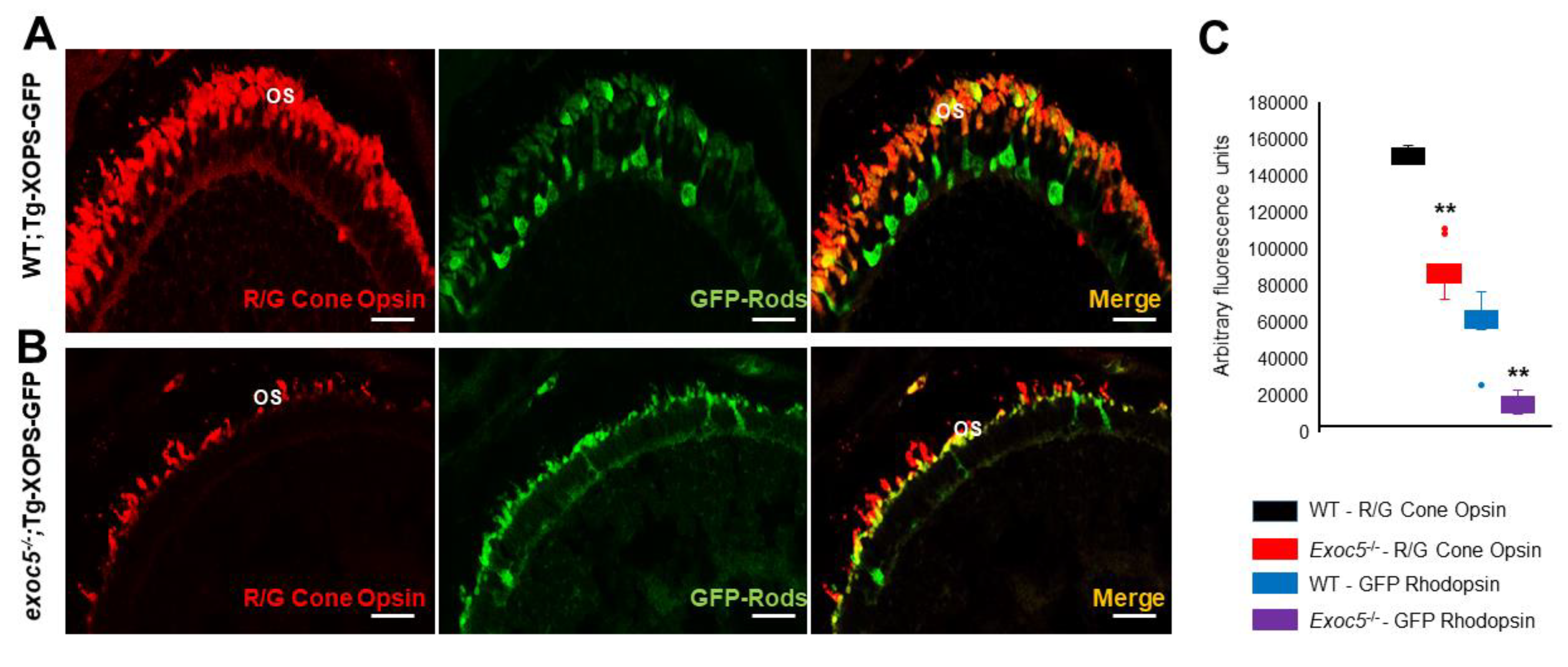
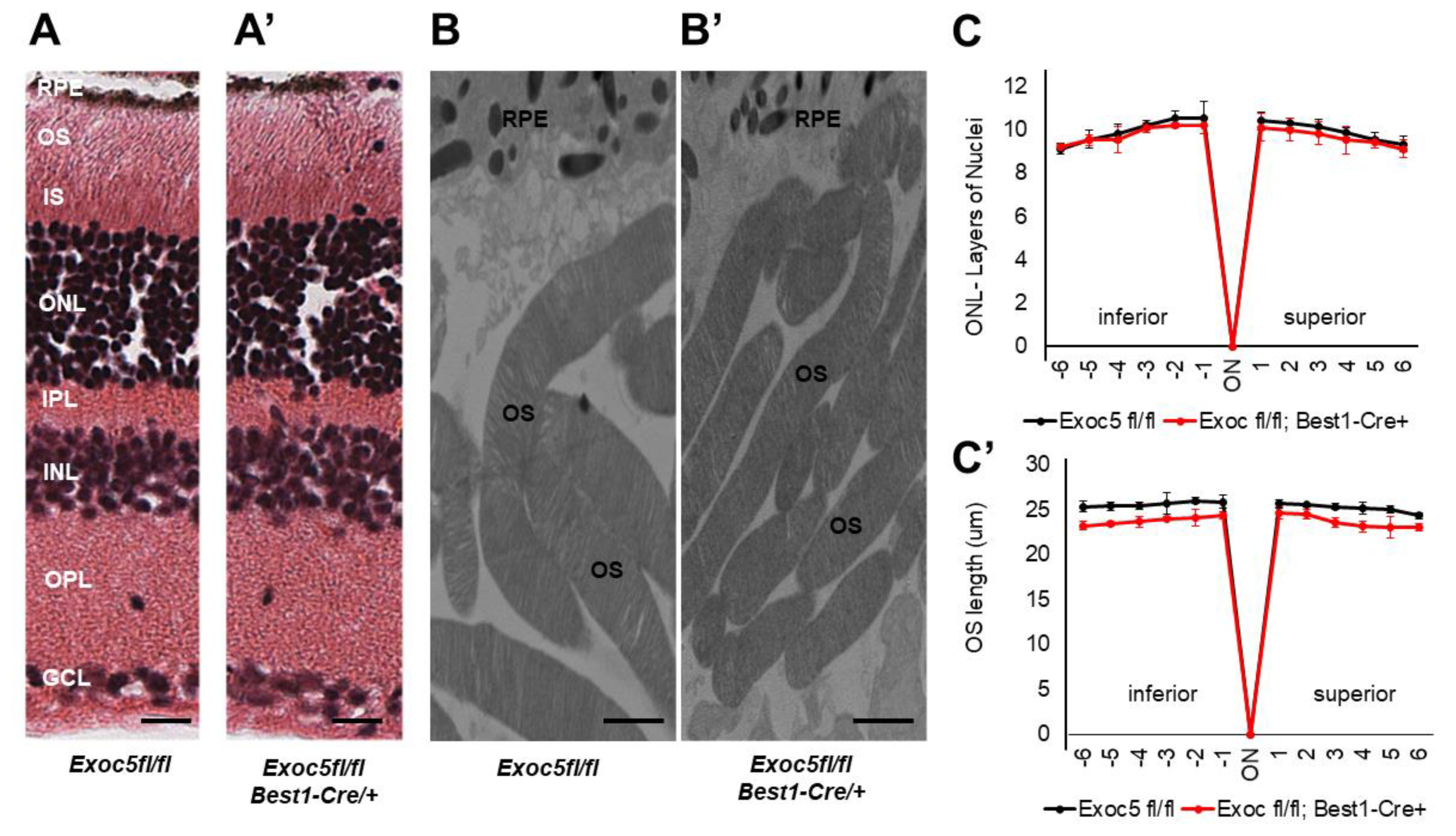


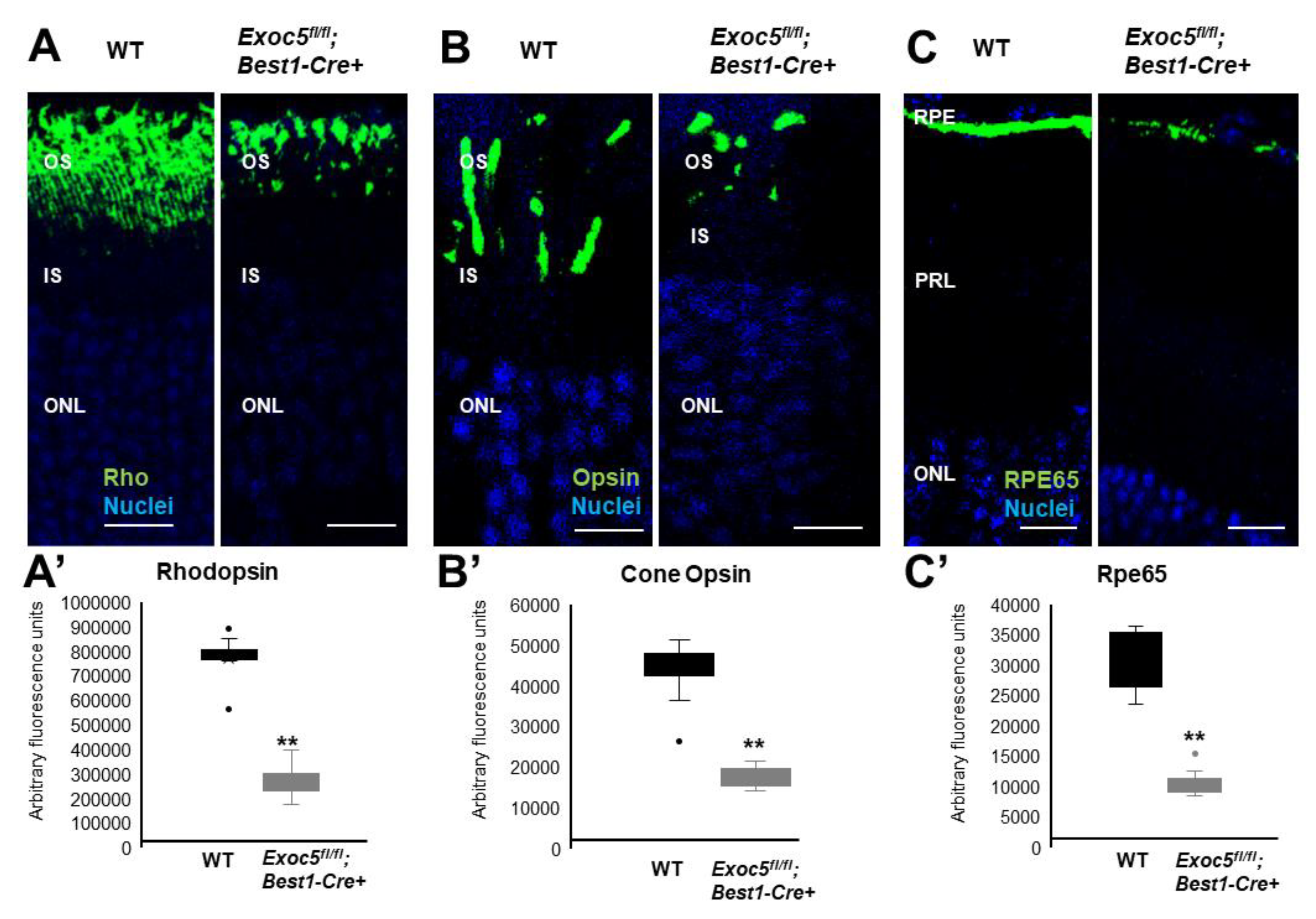
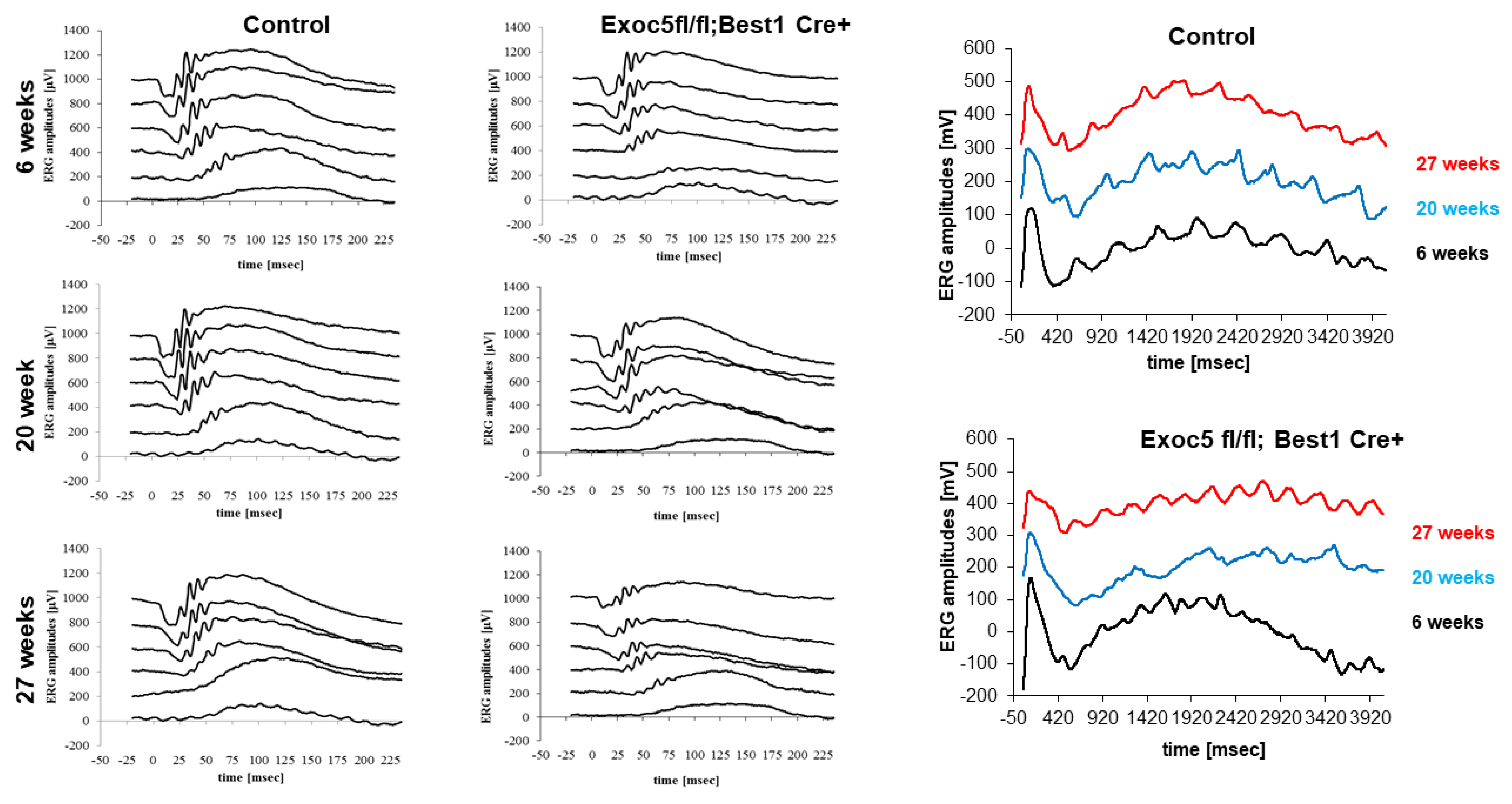
Publisher’s Note: MDPI stays neutral with regard to jurisdictional claims in published maps and institutional affiliations. |
© 2021 by the authors. Licensee MDPI, Basel, Switzerland. This article is an open access article distributed under the terms and conditions of the Creative Commons Attribution (CC BY) license (https://creativecommons.org/licenses/by/4.0/).
Share and Cite
Rohrer, B.; Biswal, M.R.; Obert, E.; Dang, Y.; Su, Y.; Zuo, X.; Fogelgren, B.; Kondkar, A.A.; Lobo, G.P.; Lipschutz, J.H. Conditional Loss of the Exocyst Component Exoc5 in Retinal Pigment Epithelium (RPE) Results in RPE Dysfunction, Photoreceptor Cell Degeneration, and Decreased Visual Function. Int. J. Mol. Sci. 2021, 22, 5083. https://doi.org/10.3390/ijms22105083
Rohrer B, Biswal MR, Obert E, Dang Y, Su Y, Zuo X, Fogelgren B, Kondkar AA, Lobo GP, Lipschutz JH. Conditional Loss of the Exocyst Component Exoc5 in Retinal Pigment Epithelium (RPE) Results in RPE Dysfunction, Photoreceptor Cell Degeneration, and Decreased Visual Function. International Journal of Molecular Sciences. 2021; 22(10):5083. https://doi.org/10.3390/ijms22105083
Chicago/Turabian StyleRohrer, Bärbel, Manas R. Biswal, Elisabeth Obert, Yujing Dang, Yanhui Su, Xiaofeng Zuo, Ben Fogelgren, Altaf A. Kondkar, Glenn P. Lobo, and Joshua H. Lipschutz. 2021. "Conditional Loss of the Exocyst Component Exoc5 in Retinal Pigment Epithelium (RPE) Results in RPE Dysfunction, Photoreceptor Cell Degeneration, and Decreased Visual Function" International Journal of Molecular Sciences 22, no. 10: 5083. https://doi.org/10.3390/ijms22105083
APA StyleRohrer, B., Biswal, M. R., Obert, E., Dang, Y., Su, Y., Zuo, X., Fogelgren, B., Kondkar, A. A., Lobo, G. P., & Lipschutz, J. H. (2021). Conditional Loss of the Exocyst Component Exoc5 in Retinal Pigment Epithelium (RPE) Results in RPE Dysfunction, Photoreceptor Cell Degeneration, and Decreased Visual Function. International Journal of Molecular Sciences, 22(10), 5083. https://doi.org/10.3390/ijms22105083






